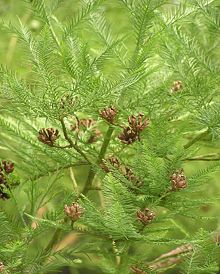- Glyptostrobus pensilis
-
Glyptostrobus pensilis 
Conservation status Scientific classification Kingdom: Plantae Division: Pinophyta Class: Pinopsida Order: Pinales Family: Cupressaceae Subfamily: Taxodioideae[2] Genus: Glyptostrobus
Endl.[3]Species: G. pensilis Binomial name Glyptostrobus pensilis
(Staunton ex D.Don) K.Koch, 1873[4]Glyptostrobus pensilis, also known as Chinese Swamp Cypress, is the sole living species in the genus Glyptostrobus. It is native to subtropical southeastern China, from Fujian west to southeast Yunnan, and also very locally in northern Vietnam.
It is a medium-sized to large tree, reaching 30 m (98 ft) tall and with a trunk diameter of up to 1 m (3.3 ft), possibly more. The leaves are deciduous, spirally arranged but twisted at the base to lie in two horizontal ranks, 5–20 mm (0.20–0.79 in) long and 1–2 mm (0.039–0.079 in) broad, but 2–3 mm (0.079–0.12 in) long and scale-like on shoots in the upper crown. The cones are green maturing yellow-brown, pear-shaped, 2–3 cm (0.79–1.2 in) long and 1–1.5 cm (0.39–0.59 in) diameter, broadest near the apex. They open when mature to release the small, 5–20 mm (0.20–0.79 in) long, winged seeds.
It typically grows in river banks, ponds and swamps, growing in water up to 60 cm (24 in) deep. Like the related genus Taxodium, it produces 'cypress knees' when growing in water, thought to help transport oxygen to the roots.
The species is nearly extinct in the wild due to overcutting for its valuable decay-resistant, scented wood, but it is also fairly widely planted[citation needed] along the banks of rice paddies where its roots help to stabilise the banks by reducing soil erosion. There appear to be no remaining wild plants in China and few of those in Viet Nam are seed-bearing.[5] There are four specimen of this tree in the Bank Hall Gardens, Lancashire, United Kingdom.
References
- ^ Farjon et al. (2005). Glyptostrobus pensilis. 2006. IUCN Red List of Threatened Species. IUCN 2006. www.iucnredlist.org. Retrieved on 6 May 2006. Database entry includes justification for why this species is endangered
- ^ "Cupressaceae Rich. ex Bartling 1830". The Gymnosperm Database. http://www.conifers.org/cu/index.htm. Retrieved 2009-10-14.
- ^ "Glyptostrobus Endl.". Germplasm Resources Information Network. United States Department of Agriculture. 2007-07-17. http://www.ars-grin.gov/cgi-bin/npgs/html/genus.pl?5037. Retrieved 2009-10-14.
- ^ "Glyptostrobus pensilis (Staunton ex D. Don) K. Koch". Germplasm Resources Information Network. United States Department of Agriculture. 2006-11-07. http://www.ars-grin.gov/cgi-bin/npgs/html/taxon.pl?17826. Retrieved 2009-10-14.
- ^ "Another leap towards the Barometer of Life". International Union for the Conservation of Nature. 10 November 2011. http://www.iucn.org/about/work/programmes/species/red_list/?8548/Another-leap-towards-the-Barometer-of-Life.
External links
Categories:- IUCN Red List critically endangered species
- Cupressaceae
- Critically endangered plants
- Plants described in 1873
- Trees of China
- Flora of Guangxi
- Flora of Vietnam
Wikimedia Foundation. 2010.

